Digital Outdoor in 2012: Stealthy Advance!
2012 is nearly over. Time to look at the outdoor advertising market and realize where it is taking us in terms of advertising budgets and technological advances. The economic crisis that started modestly in 2009 refuses to end. The good news is that negative trends in economic indices of the developed countries did not affect the advertising market significantly. Practically all countries report moderate growth in advertising budgets (approximately by 3-4% a year, starting with 2009). The forecast of advertising budgets for the period of 2013-2016 speaks about relatively low but stable increase – about 6.4% a year.
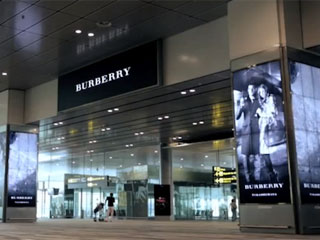 |
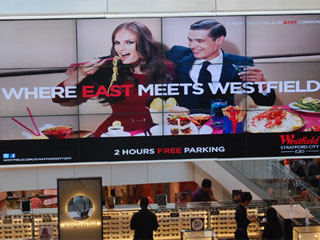 |
| LCD columns Digital 360 at Changi Airport’s Terminal 3 in Singapore Photo credit: ooh-tv.com |
Largest European LCD video wall in Westfield Stratford City shopping center (London) Photo credit: espritdigital.com |
The segment of digital advertising grows much faster up to 9% a year. In 2012 digital advertising averaged 27% of the total revenues for the OOH market. And in the next five years the digital advertising will account for 67% of growth for the whole outdoor industry. Naturally, this large number is dominated by the Internet digital component. But since the Internet is confidently moving into the out-of-home space, this trend may be considered to be indicative. The printed editions are quietly surviving or closing down and move into the digital Internet format (as it has happened with the Newsweek and The Independent).
As far as Russia is concerned, the Russ Outdoor marketing Agency reports the growth of the outdoor advertising segment to the level of 750 million US dollars in the first half of 2012 (a noticeable 12.1% growth compared to the similar period last year).
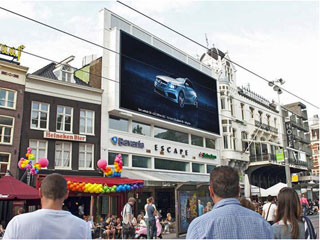 |
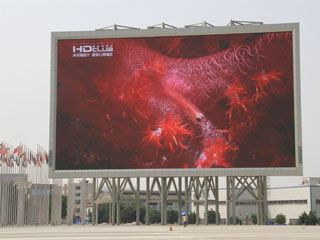 |
| Large digital billboard in Rembrandtplein Square (Amsterdam) Photo credit: digitalsignageuniverse.com |
Largest in the world LED screen 23.42x41.86 m (980 sq. m / 3904x6976 pixels) in China Photo credit: messagemaker.co.uk |
Consequently, the technological side of advertising was not too badly hurt, either. However the changes are evident. The previously identified tendency to priority growth in digital advertising technology has transferred a stable trend. More and more traditional billboards are refitted into digital format. There are numerous reasons for operators to do this:
- the advertisers have got used to digital format and no longer resist signing checks for digital outdoor advertising;
- the dynamic video advertising has fully proved its advantages over the “dead” billboard images or slide show formats, especially when it concerns popular digital branding;
- constantly improving quality of LED screens, higher energy efficiency and falling production prices opened the way to massive installation of LED screen applications and their fast return-on-investment;
- advances in IT technology and improvements in control systems allow digital media to distantly and confidently control screens and update the content practically instantaneously;
- a possibility to advertise several clients on one advertising surface (one screen) significantly increases financial efficiency of digital media etc.
The largest players in the market of outdoor advertising in the North America – Clear Channel and Lamar Advertising – have reported about conversion of more than 1000 billboards into the digital format each. Moreover, both companies publicly announced that the digital advertising finally became profitable in spite of the much higher initial investment into production of electronic components and installation.
Together with large LED screens (over 10 square meters) the city landscape is fast filling up with various formats of LCD screens installed both indoor and semi-outdoor locations.
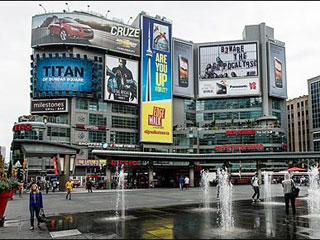 |
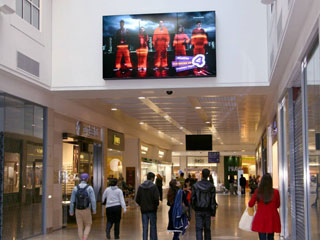 |
| Digital billboards by Titan Canada at Dundas Square in Toronto (Canada) Photo credit: capitalnetworks.com |
LCD video wall at Hounds Hill Shopping Centre, Blackpool, UK Photo credit: Ram Vision |
The number of small format LED signs has increased significantly: now the medical crosses on drugstores turned into appealing multicolor screens, bar and restaurants started replacing old signs with digital letters, monochrome running signs are changing into multi-color LED boards. Add to this large formats – especially more and more popular digital facades that drastically change the look of our cities at night time – and we get a beautiful colorful and dynamic city landscape. Even conservative European cities at night now remind of gaudy and excessive Asian trading areas.
On the whole we can talk about the following major tendencies in the development of outdoor advertising:
- wider range of advertising media and OOH advertising carriers;
- higher concentration of advertising per square unit (something that city authorities everywhere are ineffectively fighting against);
- improved creativity of outdoor advertising (mainly due to colorful video clips).
Previously it was considered that advertising is the first area that suffers in times of economic troubles. Apparently, the events of the early 21-st century prove the above statement wrong. The dip in budgets and advertising revenues that started in 2009 was quickly stopped and turned into moderate but stable growth. Seems like the modern society firmly decided in favor of digital outdoor advertising, where the LED technologies play the leading role.





